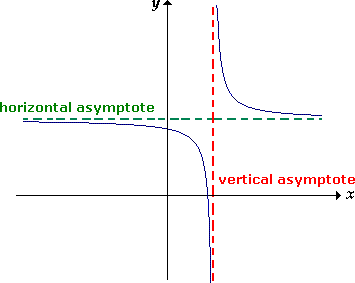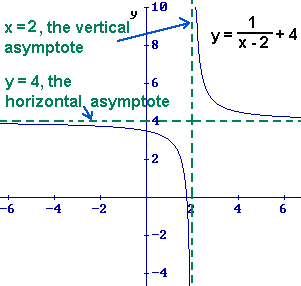Vertical and Horizontal Asymptotes
Asymptote- An asymptote is a line or curve that approaches a given curve arbitrarily closely.
Definition of vertical and horizontal asymptotes
Vertical asymptote- The line x=a is a vertical asymptote of the graph of f if f(x)→ ∞ or f(x)→ -∞ as x→ a, either from the right or from the left
Horizontal asymptote- The line y=b is a horizontal asymptote of the
graph of f if f(x)→b as x→∞ or x→ -∞
Finding Horizontal and Vertical Asymptotes
To Find Horizontal Asymptotes:
1) Put equation or function in standard form.



 =3
=3


Subtract x from both sides

 To find the y-intercept, plug in
To find the y-intercept, plug in 
 Simplify
Simplify
 Take the square root of both sides
Take the square root of both sides
 or
or  Simplify
Simplify
So the y-intercepts are (0, ) and (0,
) and (0, )
)
X intercept Go back to the original equation
Go back to the original equation
 To find the x-intercept, plug in
To find the x-intercept, plug in 
 Square 0 to get 0
Square 0 to get 0
 Multiply both sides by 4-x
Multiply both sides by 4-x
 Multiply
Multiply
 Add x to both sides
Add x to both sides
So the x-intercept is (1,0)
Asymptotes To find the vertical asymptote(s), simply set the denominator equal to zero
To find the vertical asymptote(s), simply set the denominator equal to zero
 Solve for x
Solve for x
So the vertical asymptote is at
 Go back to the original equation
Go back to the original equation
 Rearrange the terms
Rearrange the terms
Notice how the coefficient of x for the numerator and denominator is -1. So the horizontal asymptote is the ratio . Since we are dealing with a square in
. Since we are dealing with a square in  , this means that the final equation looks like
, this means that the final equation looks like  . So there are two final parts
. So there are two final parts  and
and 
This means that there is symmetry with respect with the x-axis and that there are two horizontal asymptotes and
and 

blog post by: Connor Saeli
2) Remove everything except the biggest exponents of x found in the numerator and denominator.
Examples:
Find the horizontal asymptotes of:
In order to figure out what the horizontal asymptote is, you must look at the largest degree exponent found in both the numerator and the denominator. Then, you must look at the leading coefficients for both the numerator and denominator and turn it into a fraction.
In this case, 2/3 is the horizontal asymptote of the above function. You should actually express it as y=2/3. This value is the asymptote because when we approach x=infinity, the function will always get closer and closer to y=2/3. Here's a graph of that function: 

Shortcuts:
- If the exponent in the denominator of the function is larger than the exponent in the numerator, the horizontal asymptote will be y=0, which is the x-axis.
- If there is a bigger exponent in the numerator of a given function, then there is NO horizontal asymptote. For example:
In this function, the 3 is greater than the 2 so there is no horizontal asymptote
Finding Vertical Asymptotes
1. Find the values that make the deominator equal 0
2. If any of those values don't make the numerator 0, then they are vertical asymptotes
Example:
look at the denominator in this function and set it equal to zero
3 -9=0
-9=0
solve the equation
3 =9
=9
x=1.44
So, the grapg of this function will have a vertical asymptote at x=1.44

Finding intercepts, vertical and horizontal asymptotes
Start with the given equation
Subtract x from both sides
Factor out the

Divide both sides by 

Y Intercept:
So the y-intercepts are (0,
X intercept
So the x-intercept is (1,0)
Asymptotes
So the vertical asymptote is at
Notice how the coefficient of x for the numerator and denominator is -1. So the horizontal asymptote is the ratio
This means that there is symmetry with respect with the x-axis and that there are two horizontal asymptotes
Extra Help
blog post by: Connor Saeli


No comments:
Post a Comment